Theories of Social: Feminism, Intersectionality, Foucault, Beauvoir
VerifiedAdded on 2021/06/16
|5
|1045
|77
Essay
AI Summary
This essay delves into key social theories, focusing on feminism, intersectionality, and the contributions of Michel Foucault and Simone de Beauvoir. It begins by defining feminism and its core principle of promoting equality between the sexes, then explores different feminist theories, including liberal feminism and post-structural feminism, and the concept of intersectional feminism. The essay then analyzes Foucault's theory of disciplinary power, particularly his examination of the prison system and its role in social control, and De Beauvoir's insights on the historical treatment of women and the concept of the 'other'. The essay references relevant academic sources and provides a comprehensive overview of the selected social theories, highlighting their significance in understanding social dynamics, power structures, and gender inequality.
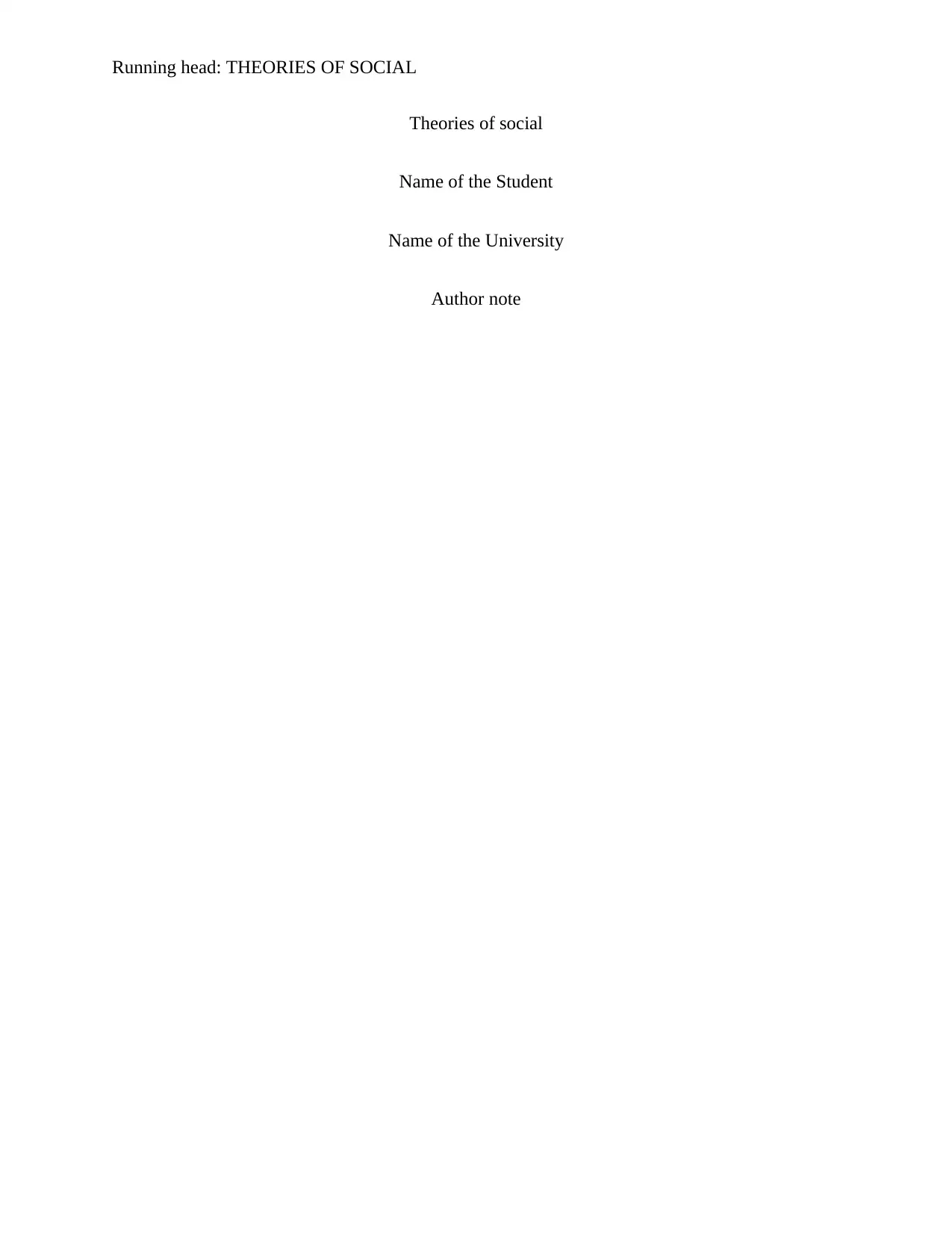
Running head: THEORIES OF SOCIAL
Theories of social
Name of the Student
Name of the University
Author note
Theories of social
Name of the Student
Name of the University
Author note
Paraphrase This Document
Need a fresh take? Get an instant paraphrase of this document with our AI Paraphraser
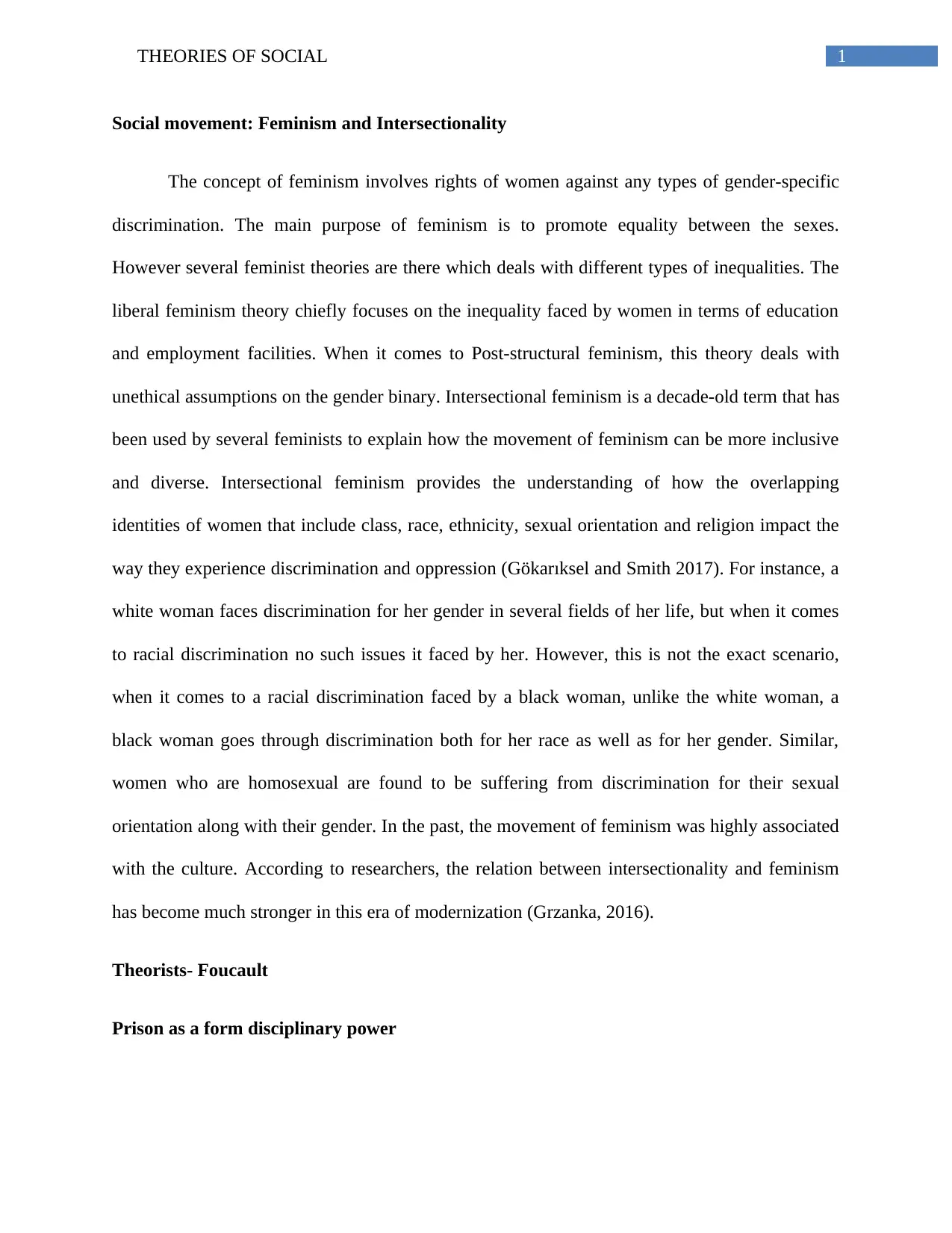
1THEORIES OF SOCIAL
Social movement: Feminism and Intersectionality
The concept of feminism involves rights of women against any types of gender-specific
discrimination. The main purpose of feminism is to promote equality between the sexes.
However several feminist theories are there which deals with different types of inequalities. The
liberal feminism theory chiefly focuses on the inequality faced by women in terms of education
and employment facilities. When it comes to Post-structural feminism, this theory deals with
unethical assumptions on the gender binary. Intersectional feminism is a decade-old term that has
been used by several feminists to explain how the movement of feminism can be more inclusive
and diverse. Intersectional feminism provides the understanding of how the overlapping
identities of women that include class, race, ethnicity, sexual orientation and religion impact the
way they experience discrimination and oppression (Gökarıksel and Smith 2017). For instance, a
white woman faces discrimination for her gender in several fields of her life, but when it comes
to racial discrimination no such issues it faced by her. However, this is not the exact scenario,
when it comes to a racial discrimination faced by a black woman, unlike the white woman, a
black woman goes through discrimination both for her race as well as for her gender. Similar,
women who are homosexual are found to be suffering from discrimination for their sexual
orientation along with their gender. In the past, the movement of feminism was highly associated
with the culture. According to researchers, the relation between intersectionality and feminism
has become much stronger in this era of modernization (Grzanka, 2016).
Theorists- Foucault
Prison as a form disciplinary power
Social movement: Feminism and Intersectionality
The concept of feminism involves rights of women against any types of gender-specific
discrimination. The main purpose of feminism is to promote equality between the sexes.
However several feminist theories are there which deals with different types of inequalities. The
liberal feminism theory chiefly focuses on the inequality faced by women in terms of education
and employment facilities. When it comes to Post-structural feminism, this theory deals with
unethical assumptions on the gender binary. Intersectional feminism is a decade-old term that has
been used by several feminists to explain how the movement of feminism can be more inclusive
and diverse. Intersectional feminism provides the understanding of how the overlapping
identities of women that include class, race, ethnicity, sexual orientation and religion impact the
way they experience discrimination and oppression (Gökarıksel and Smith 2017). For instance, a
white woman faces discrimination for her gender in several fields of her life, but when it comes
to racial discrimination no such issues it faced by her. However, this is not the exact scenario,
when it comes to a racial discrimination faced by a black woman, unlike the white woman, a
black woman goes through discrimination both for her race as well as for her gender. Similar,
women who are homosexual are found to be suffering from discrimination for their sexual
orientation along with their gender. In the past, the movement of feminism was highly associated
with the culture. According to researchers, the relation between intersectionality and feminism
has become much stronger in this era of modernization (Grzanka, 2016).
Theorists- Foucault
Prison as a form disciplinary power
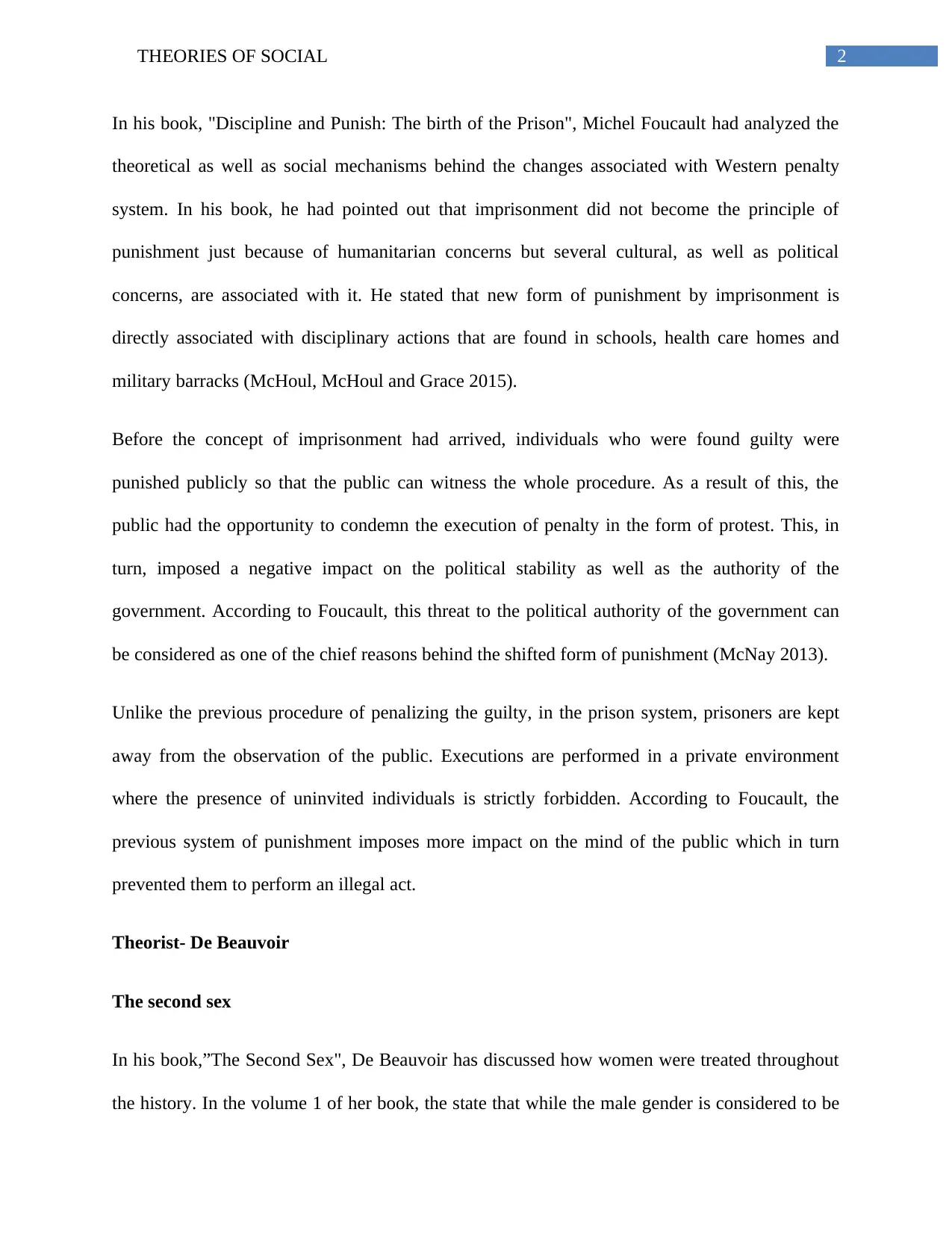
2THEORIES OF SOCIAL
In his book, "Discipline and Punish: The birth of the Prison", Michel Foucault had analyzed the
theoretical as well as social mechanisms behind the changes associated with Western penalty
system. In his book, he had pointed out that imprisonment did not become the principle of
punishment just because of humanitarian concerns but several cultural, as well as political
concerns, are associated with it. He stated that new form of punishment by imprisonment is
directly associated with disciplinary actions that are found in schools, health care homes and
military barracks (McHoul, McHoul and Grace 2015).
Before the concept of imprisonment had arrived, individuals who were found guilty were
punished publicly so that the public can witness the whole procedure. As a result of this, the
public had the opportunity to condemn the execution of penalty in the form of protest. This, in
turn, imposed a negative impact on the political stability as well as the authority of the
government. According to Foucault, this threat to the political authority of the government can
be considered as one of the chief reasons behind the shifted form of punishment (McNay 2013).
Unlike the previous procedure of penalizing the guilty, in the prison system, prisoners are kept
away from the observation of the public. Executions are performed in a private environment
where the presence of uninvited individuals is strictly forbidden. According to Foucault, the
previous system of punishment imposes more impact on the mind of the public which in turn
prevented them to perform an illegal act.
Theorist- De Beauvoir
The second sex
In his book,”The Second Sex", De Beauvoir has discussed how women were treated throughout
the history. In the volume 1 of her book, the state that while the male gender is considered to be
In his book, "Discipline and Punish: The birth of the Prison", Michel Foucault had analyzed the
theoretical as well as social mechanisms behind the changes associated with Western penalty
system. In his book, he had pointed out that imprisonment did not become the principle of
punishment just because of humanitarian concerns but several cultural, as well as political
concerns, are associated with it. He stated that new form of punishment by imprisonment is
directly associated with disciplinary actions that are found in schools, health care homes and
military barracks (McHoul, McHoul and Grace 2015).
Before the concept of imprisonment had arrived, individuals who were found guilty were
punished publicly so that the public can witness the whole procedure. As a result of this, the
public had the opportunity to condemn the execution of penalty in the form of protest. This, in
turn, imposed a negative impact on the political stability as well as the authority of the
government. According to Foucault, this threat to the political authority of the government can
be considered as one of the chief reasons behind the shifted form of punishment (McNay 2013).
Unlike the previous procedure of penalizing the guilty, in the prison system, prisoners are kept
away from the observation of the public. Executions are performed in a private environment
where the presence of uninvited individuals is strictly forbidden. According to Foucault, the
previous system of punishment imposes more impact on the mind of the public which in turn
prevented them to perform an illegal act.
Theorist- De Beauvoir
The second sex
In his book,”The Second Sex", De Beauvoir has discussed how women were treated throughout
the history. In the volume 1 of her book, the state that while the male gender is considered to be
⊘ This is a preview!⊘
Do you want full access?
Subscribe today to unlock all pages.

Trusted by 1+ million students worldwide
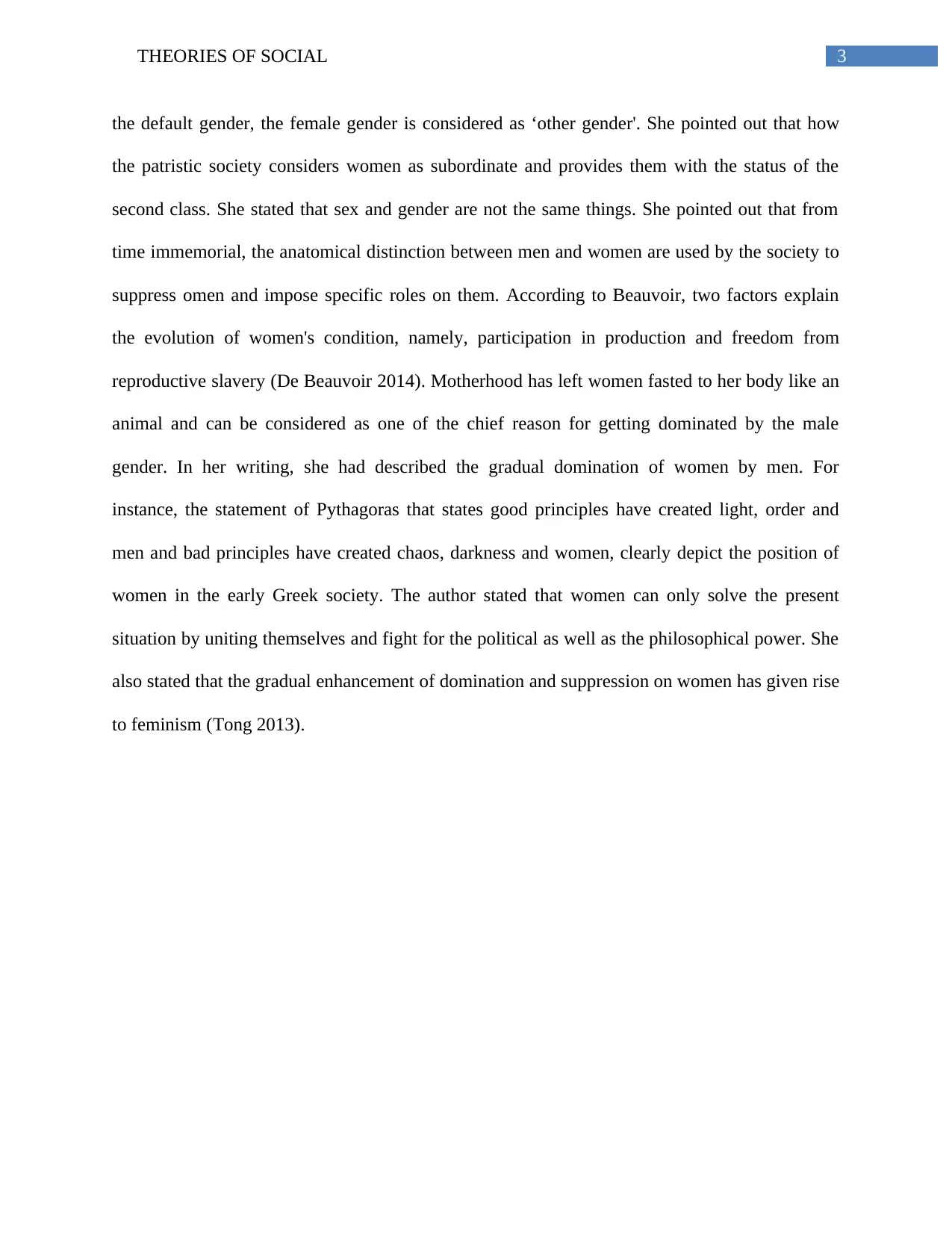
3THEORIES OF SOCIAL
the default gender, the female gender is considered as ‘other gender'. She pointed out that how
the patristic society considers women as subordinate and provides them with the status of the
second class. She stated that sex and gender are not the same things. She pointed out that from
time immemorial, the anatomical distinction between men and women are used by the society to
suppress omen and impose specific roles on them. According to Beauvoir, two factors explain
the evolution of women's condition, namely, participation in production and freedom from
reproductive slavery (De Beauvoir 2014). Motherhood has left women fasted to her body like an
animal and can be considered as one of the chief reason for getting dominated by the male
gender. In her writing, she had described the gradual domination of women by men. For
instance, the statement of Pythagoras that states good principles have created light, order and
men and bad principles have created chaos, darkness and women, clearly depict the position of
women in the early Greek society. The author stated that women can only solve the present
situation by uniting themselves and fight for the political as well as the philosophical power. She
also stated that the gradual enhancement of domination and suppression on women has given rise
to feminism (Tong 2013).
the default gender, the female gender is considered as ‘other gender'. She pointed out that how
the patristic society considers women as subordinate and provides them with the status of the
second class. She stated that sex and gender are not the same things. She pointed out that from
time immemorial, the anatomical distinction between men and women are used by the society to
suppress omen and impose specific roles on them. According to Beauvoir, two factors explain
the evolution of women's condition, namely, participation in production and freedom from
reproductive slavery (De Beauvoir 2014). Motherhood has left women fasted to her body like an
animal and can be considered as one of the chief reason for getting dominated by the male
gender. In her writing, she had described the gradual domination of women by men. For
instance, the statement of Pythagoras that states good principles have created light, order and
men and bad principles have created chaos, darkness and women, clearly depict the position of
women in the early Greek society. The author stated that women can only solve the present
situation by uniting themselves and fight for the political as well as the philosophical power. She
also stated that the gradual enhancement of domination and suppression on women has given rise
to feminism (Tong 2013).
Paraphrase This Document
Need a fresh take? Get an instant paraphrase of this document with our AI Paraphraser
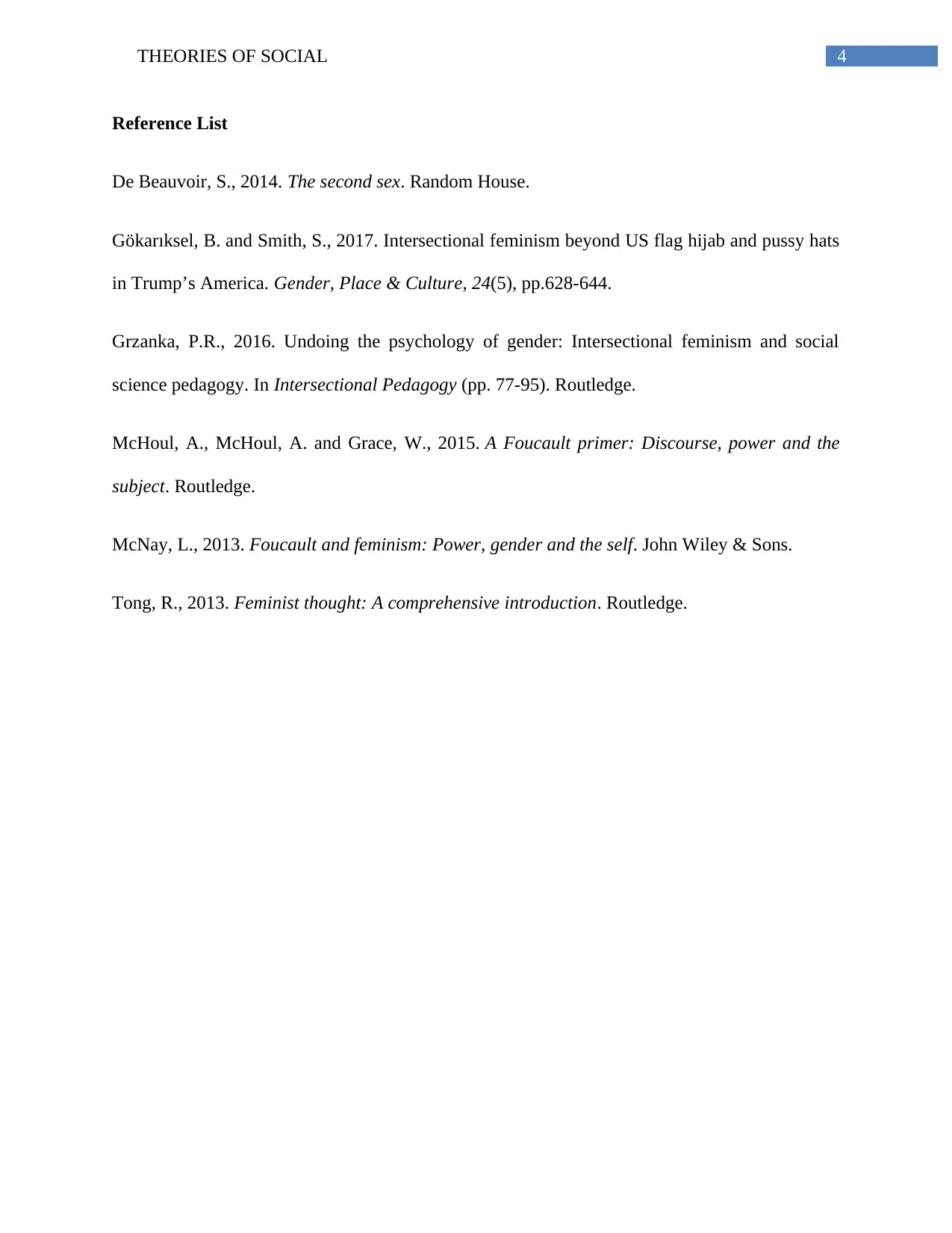
4THEORIES OF SOCIAL
Reference List
De Beauvoir, S., 2014. The second sex. Random House.
Gökarıksel, B. and Smith, S., 2017. Intersectional feminism beyond US flag hijab and pussy hats
in Trump’s America. Gender, Place & Culture, 24(5), pp.628-644.
Grzanka, P.R., 2016. Undoing the psychology of gender: Intersectional feminism and social
science pedagogy. In Intersectional Pedagogy (pp. 77-95). Routledge.
McHoul, A., McHoul, A. and Grace, W., 2015. A Foucault primer: Discourse, power and the
subject. Routledge.
McNay, L., 2013. Foucault and feminism: Power, gender and the self. John Wiley & Sons.
Tong, R., 2013. Feminist thought: A comprehensive introduction. Routledge.
Reference List
De Beauvoir, S., 2014. The second sex. Random House.
Gökarıksel, B. and Smith, S., 2017. Intersectional feminism beyond US flag hijab and pussy hats
in Trump’s America. Gender, Place & Culture, 24(5), pp.628-644.
Grzanka, P.R., 2016. Undoing the psychology of gender: Intersectional feminism and social
science pedagogy. In Intersectional Pedagogy (pp. 77-95). Routledge.
McHoul, A., McHoul, A. and Grace, W., 2015. A Foucault primer: Discourse, power and the
subject. Routledge.
McNay, L., 2013. Foucault and feminism: Power, gender and the self. John Wiley & Sons.
Tong, R., 2013. Feminist thought: A comprehensive introduction. Routledge.
1 out of 5
Related Documents
Your All-in-One AI-Powered Toolkit for Academic Success.
+13062052269
info@desklib.com
Available 24*7 on WhatsApp / Email
![[object Object]](/_next/static/media/star-bottom.7253800d.svg)
Unlock your academic potential
Copyright © 2020–2025 A2Z Services. All Rights Reserved. Developed and managed by ZUCOL.



